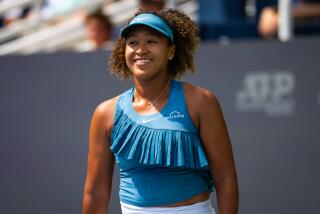Lloyd Is Getting Older, but She’s Getting Better
- Share via
NEW YORK — West Germany’s Claudia Kohde-Kilsch, who has been described as the future of women’s tennis, went racket-to-racket against the past Tuesday afternoon and came away with some disconcerting news about the present.
Chris Evert Lloyd, with a body nearing 31 years of age and a right arm that has launched about a billion forehands, is actually getting better .
Kohde-Kilsch, a 6-3, 6-3 loser to Lloyd in the U.S. Open women’s quarterfinals, swears it’s so.
“She is at the top of her game right now,” Kohde-Kilsch said. “She is even faster than before, she has a harder first serve and she hits all of her strokes harder.
“It’s probably because she wants to be No. 1 again. Now, she is--and she wants to stay there. The competition she has from other players is getting better, and she has decided to work more.”
Lloyd doesn’t disagree.
“You know, one of the reasons I’m still in the game is because I think I can improve,” she said. “If I felt my best years were over, I definitely would have retired by now. But I don’t feel, physically, that I’ve peaked.”
Maybe Kohde-Kilsch is right. Maybe Lloyd speaks the truth.
But, physically, this isn’t supposed to happen.
Tennis players aren’t supposed to peak during their 14th year on the tour.
Not after more than 1,000 singles victories and 140 tournament championships.
Not when they broke in before several of sport’s current emerging stars--Gabriela Sabatini, Mary Joe Fernandez--were even born.
Not after they have seen several careers--Tracy Austin, Andrea Jaeger--come and go.
But, there is reason to believe in this anomaly. After slipping into the background while Martina Navratilova threatened to turn the game into a one-woman sport, Lloyd has pulled even again. She has beaten Navratilova twice this year--once in the French Open final--and is back atop the world computer rankings for the first time since 1981.
Seeded first at Flushing Meadow, Lloyd has played 10 sets through the first five rounds--and won them all. Only one went as far as 6-4.
And, perhaps most impressively, she made Kohde-Kilsch look like just another straight-sets victim.
It has gone largely unnoticed in this, the summer of Boom Boom, but Kohde-Kilsch has showed that there is more to West German tennis than Boris Becker. She reached the French Open semifinals, won the Virginia Slims of Los Angeles title and, during a one-week span last month, scored victories over Hana Mandlikova, Pam Shriver and Martina Navratilova.
Kohde-Kilsch has been called the prototype for the breed of contender on the women’s pro tour--young (21), tall (6-1) and armed with a crackling serve-and-volley attack.
But in the U.S. Open quarterfinals, Lloyd sent this year’s model back to the factory for revisions.
“I have to play more consistent against her,” said Kohde-Kilsch, now 0-9 against Lloyd. “I’m still missing too many shots because I’m going for great shots. I have to serve better and not miss easy shots against her.”
For Kohde-Kilsch to beat Lloyd, her net game has to be near perfection. Tuesday, it wasn’t. Kohde-Kilsch committed 29 unforced errors.
Lloyd pounces on unforced errors. In typical style, she ground down Kohde-Kilsch with rallies from the baseline. The backcourt remains Lloyd’s private domain.
But Lloyd--and this is an upset--also beat Kohde-Kilsch, more than once, at the net. Lloyd won points with her serve, with slicing approach shots and, on one rare occasion in the first set, with a leaping, crushing overhead.
Chris Evert Lloyd playing power tennis? That was simply too much for Kohde-Kilsch to comprehend.
“She’s the only one in the Top 10 I haven’t beaten yet,” Kohde-Kilsch said. “I don’t like her game.
“If you play too much from the baseline, you let her get her rhythm. (But) it’s always hard to come in during a rally because she makes you run a lot and hits deep.”
Then, Kohde-Kilsch touched upon the very essence of Lloyd’s long-running success.
“I have to win the points by myself,” Kohde-Kilsch said, a common complaint of a Lloyd opponent.
There are few handouts to be had in a match against Lloyd. She allowed just 14 unforced errors against Kohde-Kilsch.
What you get against Lloyd, you have to work for.
That has been Lloyd’s modus operandi for years. Sometimes, the fact that it remains the same after 14 years amazes even Lloyd.
“Sometimes, I wonder how I’ve lasted this long,” Lloyd said. “Physically, I’ve been lucky. I’ve never had any injuries, knock on wood. I’ve never been out for a year from knee surgery or anything.
“Mentally, I think that is what is going to be the thing that retires me, that makes me stop. I don’t know how intense I can be year after year.”
Lloyd has contemplated retirement numerous times. It has become one of the re-occurring stories on the tennis circuit: McEnroe Throws Tantrum; Chrissie May Call It Quits.
Ironically, becoming older has altered Lloyd’s thinking on retirement.
“Right now, one of the reasons I’m still playing is that I know that I’m not going to have this career the rest of my life,” she said. “The motivating force is that I know one morning, I’m going to wake up and it’s going to take me an hour to get out of bed. And I’m going to be aching. And then, the tennis will be over and done with.
“I’m just trying to enjoy the last part of it right now.”
Another motivation for Lloyd: The allure of another U.S. Open title.
She’s two victories away. Next up is a semifinal confrontation with Hana Mandlikova. Then, in all likelihood, another reunion with Navratilova.
That is how the past two U.S. Opens have finished for the women. Both times, Navratilova defeated Lloyd.
But that could change in 1985. Remember, Chris Evert Lloyd is No. 1 again.
And, she’s getting better.
More to Read
Go beyond the scoreboard
Get the latest on L.A.'s teams in the daily Sports Report newsletter.
You may occasionally receive promotional content from the Los Angeles Times.










